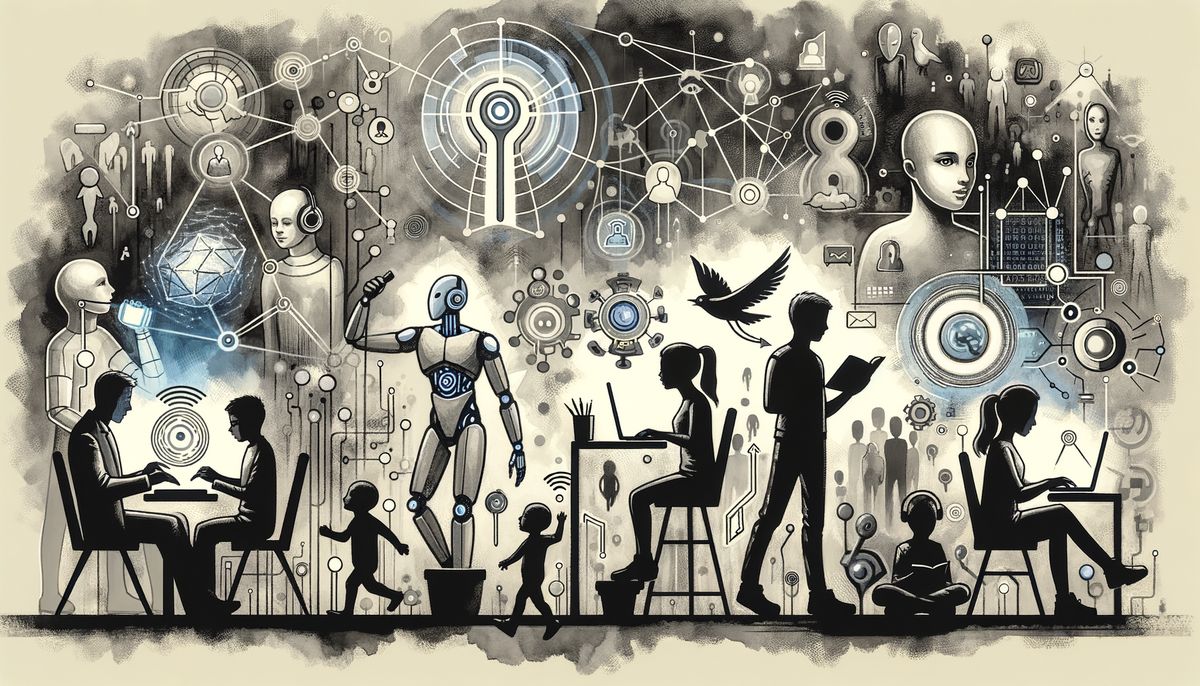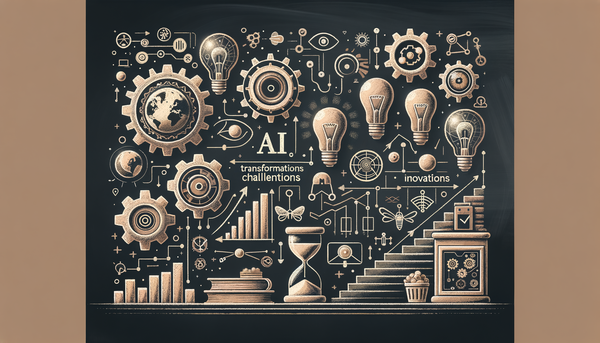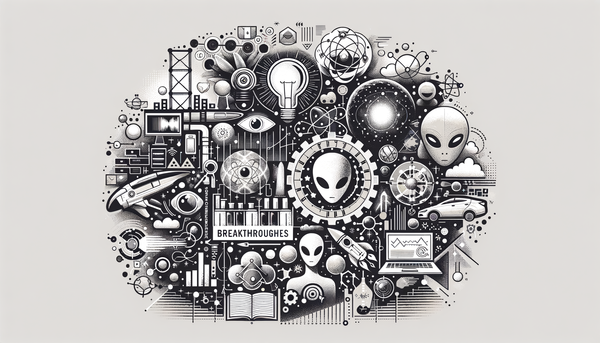AI Updates: Streamlining Enterprise Automation and Challenges Ahead

In this comprehensive exploration, we delve into the transformative impact of artificial intelligence across diverse industries—from cybersecurity automation and enterprise modernization to cross-border data utilization, breakthrough innovations in voice technology, academic experimentation, strategic pivots in digital entertainment, and a growing demand for ethical AI practices. This article unpacks recent developments and offers insights into the current AI landscape, drawing on examples from Microsoft’s cutting-edge Security Copilot, Oracle’s enterprise AI agent studio, emerging trends in voice AI and Web3 data, experimental uses of AI in education, Kuaishou’s renewed AI commitment, and the rising emphasis on responsible AI from institutional investors.
Automating Cybersecurity: Microsoft’s Security Copilot and AI Agents
Recent innovations in cybersecurity have set a new benchmark by harnessing the power of AI to automate routine security tasks. Microsoft is spearheading this transformation with its Security Copilot, a tool designed to support security professionals by streamlining laborious tasks that once consumed countless hours of manual effort. This service introduces a suite of six in-house AI agents, each engineered to tackle a specific challenge within cybersecurity operations.
Among these, the Phishing Triage Agent stands out by analyzing phishing alerts with remarkable precision. It expertly distinguishes between genuine threats and false alarms, allowing security teams to prioritize their responses efficiently. Complementing this, two distinct Alert Triage Agents integrated into Microsoft Purview help sift through data misuse notifications, unveiling instances where business data may have been improperly handled. The practical impact of these innovations is profound: with alert systems that can predict and flag unsafe configurations – notably through the Conditional Access Optimization Agent in Microsoft Entra – administrators can act on potential vulnerabilities with a single click.
Moreover, the Vulnerability Remediation Agent within Microsoft Intune accelerates the process of identifying weak points across various endpoints. By streamlining the deployment of critical operating system updates, it minimizes exposure to exploits while the Threat Intelligence Briefing Agent keeps teams informed with prompt, actionable security reports. Not only does this series of agents provide a robust shield against cyber threats, it also illustrates how AI can reduce repetitive work, enabling professionals to focus on strategic defense measures.
A fascinating aspect of this development is the collaborative approach being adopted. Microsoft has partnered with companies like Aviatrix Systems, OneTrust, Tanium, Fletch, and BlueVoyant to enrich its security ecosystem. Each partner brings targeted solutions—for instance, Aviatrix’s agent addresses networking challenges while OneTrust’s focuses sharply on privacy compliance. The synthesis of these technologies offers a comprehensive framework for tackling a spectrum of cybersecurity challenges in today’s fast-paced digital world.
"Automation in security transforms the landscape, making it possible to shift focus from mundane tasks to strategic threat analysis," a notable observer remarked, encapsulating the essence of Microsoft’s innovative approach.
This breakthrough in automated security can also be seen as part of a larger trend, where AI is being applied to understand and predict security threats in real time. For instance, enterprises have begun leveraging similar technologies as seen in related industry updates, such as the expansion of cloud-based intelligent solutions (read more on AI.Biz) and the development of autonomous AI agents by technology giants (discover the details).
Oracle’s AI Agent Studio: Streamlining Enterprise Automation
While cybersecurity sees one face of artificial intelligence, another defining application lies in the realm of enterprise automation. Oracle is currently revolutionizing this sector with its AI Agent Studio. With the primary goal of streamlining enterprise workflows, Oracle’s new platform promises to simplify complex business processes by embedding AI capabilities directly into everyday operations.
Oracle’s approach is both proactive and inclusive. By empowering businesses to build custom AI agents, the platform addresses unique challenges that traditional automation frameworks often overlook. Whether it’s fine-tuning internal communication channels or optimizing supply chain logistics, the potential applications for Oracle’s AI Agent Studio are boundless.
This enterprise-centric AI strategy is significant because it takes a modular and flexible approach. Companies can design agents that align with their internal processes and integrate them into both legacy systems and modern cloud applications. Such adaptability is crucial in today’s competitive market, where agility and rapid adaptation dictate success.
A practical scenario would be a multinational corporation using Oracle’s studio to deploy AI agents that automatically handle invoicing, monitor financial compliance, or even predict maintenance issues across different operational sites. By removing repetitive data processing and manual oversight, businesses can divert resources toward more strategic initiatives, fostering innovation and growth.
"Oracle’s venture into AI represents a step forward in not just technology, but in the empowerment of business processes at every level," one industry expert explained.
For those interested in broadening their horizon on how AI is reshaping enterprise solutions, you might cross-examine similar topics on our site. Check out updates like Oracle’s broader AI innovations in payment and healthcare solutions (explore further) or learn how businesses are accessing customizable AI tools (read further).
Innovations in Voice AI: Berlin's ai|coustics and Studio-Quality Sound
Beyond the domains of cybersecurity and enterprise automation, artificial intelligence continues to reshape the audio landscape. Recently, Berlin-based startup ai|coustics has raised €5M in a seed round, an impressive infusion of funding aimed at bringing studio-quality sound to Voice AI applications. Although details about the startup's endeavors remain under wraps, the implications are significant.
Voice AI has been an evolving field, transforming the way we interact with technology—from virtual assistants to state-of-the-art audio mastering. The promise of studio-quality sound is particularly enticing in sectors ranging from music production to customer service. Imagine engaging with a digital assistant whose voice is indistinguishable from a seasoned radio host, or utilizing AI to produce crisp, clear audio for streaming services without the need for extensive post-production work.
Funding such as this not only indicates strong investor confidence but also signals an expanding market that values high-fidelity audio integrated into smart systems. The breakthrough potential spans various industries, whether in entertainment, education, or corporate communications. In many ways, this venture underscores the versatility of AI, demonstrating that its utility is not confined to text-based analytics or data-driven tasks alone.
As the technology matures, such initiatives could lead to an era where the boundaries between human and machine-generated sound blur, ultimately creating richer, more engaging user experiences. This transformation is part of a broader narrative where AI technologies continuously expand their reach into creative and perceptual domains.
Harnessing Cross-Border Data: China’s Web3 and Industrial AI Integration
The global stage for AI innovation is vast, and a compelling chapter is unfolding in China. A recent exploration reveals that China is pioneering the integration of cross-border AI data to enhance industrial applications—a milestone that also marks a significant leap into the realm of Web3. By leveraging vast pools of data that traverse geopolitical boundaries, Chinese enterprises and researchers are now able to drive smarter industrial processes and foster innovation at an unprecedented scale.
At the heart of this development lies the confluence of AI with blockchain and decentralized data infrastructures. Such a blend enables secure and verifiable data transfer across borders, an essential attribute for industrial applications that depend on real-time information from multiple locations. In the manufacturing and logistics sectors, for example, AI systems can now aggregate diverse datasets to optimize production lines, predict maintenance, and even dynamically adjust supply chains.
The application of AI in this context is transformative. It not only accelerates traditional industries but also facilitates a more integrated global approach to resource management and industrial productivity. By overcoming borders in data exchange, companies stand to benefit from more robust insights and a more responsive industrial environment.
This paradigm shift, powered by both Web3 advancements and AI capabilities, speaks to the future of interconnected global industries. As firms align with these trends, regulators and industry stakeholders must also collaborate, ensuring that this expansion is both innovative and secure.
Academic Experimentation: AI in Scholarship Essay Writing
Not all applications of AI are met with wide acclaim, and some offer lessons in both opportunity and limitation. A recent investigation into the use of AI for writing scholarship essays has yielded mixed results. Students turning to artificial intelligence to craft essays found that while AI can assist with drafting and ideation, the results often fall short of the originality and critical nuance required by academic standards.
This exploration highlights an important dichotomy: the power of AI to process information and generate content versus the unique cognitive abilities of human creativity and critical analysis. While AI tools can provide a useful starting point for structuring thoughts or overcoming writer’s block, they currently struggle to infuse essays with the depth and context that scholarship committees prize highly.
Furthermore, the experience has underscored the limitations inherent in current AI models. Despite being trained on vast amounts of data, these systems may lack the ability to fully comprehend subtle contextual cues, irony, or the personal experiences that form the heart of compelling essays. This observation reinforces the perspective echoed by notable figures such as Stephen Hawking, who once remarked, "AI is likely to be either the best or worst thing to happen to humanity." Clearly, while promising, artificial intelligence still has considerable ground to cover before it can replicate the nuanced understanding of a human mind.
"The day healthcare can fully embrace AI is the day we have a revolution in terms of cutting costs and improving care," noted Fei-Fei Li—an idea that resonates even as we explore the limits and potential of AI in academic creativity.
This academic case study serves as an important reminder that artificial intelligence, despite its rapid advancement, is best viewed as a supplementary tool rather than a complete replacement for human ingenuity. It invites educators, technologists, and students alike to rethink how best to integrate these tools while preserving the distinct qualities that define human scholarship.
Revitalizing Digital Entertainment: Kuaishou’s AI-Powered Transformation
Turning our gaze to the vibrant world of digital media, we encounter Kuaishou—a leading Chinese video-sharing platform that has recently announced a strategic shift towards deepening its AI integration. Backed by Tencent, Kuaishou is facing a challenging market environment where sales growth has notably slowed. In response, the company is harnessing the power of AI to reinvigorate its platform and reshape user engagement.
The renewed focus is expected to have multiple layers of impact. On the user front, AI algorithms are being fine-tuned to deliver personalized content recommendations, ensuring that every viewer receives a tailored experience. At the same time, these algorithms are employed to enhance content moderation, a critical task in the constantly evolving digital media landscape. By automatically detecting and filtering inappropriate content, AI is poised to improve the overall quality of user experience while also supporting community guidelines.
Moreover, the strategic shift also extends to content creators. With advanced performance analytics and monetization assistance powered by AI, creators can gain actionable insights into their audience’s preferences. This dual approach not only sustains engagement but also cultivates a supportive ecosystem for creative talent—an ecosystem that is critical for long-term success in the digital age.
Kuaishou’s pivot to AI epitomizes the broader trend where digital platforms are leveraging cutting-edge technologies to maintain their competitive edge. In an industry characterized by rapid changes and shifting consumer behaviors, the embrace of AI offers a path to renewed dynamism and innovation.
The Imperative of Responsible AI
As AI technologies proliferate across sectors, a resonant theme emerges: the need for responsible, ethical AI practices. Recent discussions among big institutional limited partners have underscored that responsible AI isn’t merely a technical challenge but a vital component of sustainable investment and innovation. Investors now closely scrutinize the ethical deployment of AI, pressing companies to prioritize transparency, fairness, and accountability in their operations.
Responsible AI involves ensuring that algorithms are free from bias, that data privacy is rigorously maintained, and that the implementation of AI systems does not compromise societal values. This ethical framework is particularly important as more applications – ranging from cybersecurity automation to enterprise processes and content moderation – become deeply integrated into everyday life.
Furthermore, as industry standards evolve, the insights gleaned from these responsible AI developments are influencing regulatory frameworks and best practices. Companies that invest in responsible AI can build trust with their users and stakeholders, enabling them to harness the full potential of these technologies while mitigating risks.
In many ways, the discussion about responsible AI is a call to action for industry leaders, researchers, and policymakers alike to work collaboratively. By doing so, the AI community can navigate a future that maximizes innovation while ensuring that ethical considerations remain at the forefront of technological progress.
Looking Forward: The Expanding Horizons of Artificial Intelligence
The threads of discussion running through contemporary AI innovations—from cybersecurity and enterprise automation to audio excellence, cross-border data strategies, academic experiments, and digital media revitalization—paint a picture of a rapidly evolving landscape. Artificial intelligence is no longer a futuristic concept; it is a present-day reality driving transformation across multiple facets of business and society.
Consider, for instance, the projected integration of Microsoft’s security functionality with platforms like Google Cloud, Azure, and AWS, beginning in 2025. Such cross-platform integrations signal a future where AI-driven security and automation become ubiquitous. Similarly, Oracle’s modular approach in its AI Agent Studio hints at a paradigm shift in how businesses will approach automation in the coming years. These trends have already sparked a cascade of related developments, evidenced by exciting updates on our AI.Biz website—ranging from AI-driven enterprise solutions to innovative applications in healthcare and finance (dive into the details here).
On the creative side, initiatives like Berlin-based ai|coustics’ venture into studio-quality Voice AI and the mixed results observed in academic applications of AI-based essay writing remind us that the technology is multifaceted. It offers remarkable capabilities while also delineating clear boundaries where human ingenuity remains paramount. The journey forward, therefore, requires a nuanced balance between leveraging AI’s strengths and acknowledging its current limitations.
Interestingly, amid all these technical advancements, the underlying ethos captured by experts resonates strongly. As Fei-Fei Li once shared, "As a technologist, I see how AI and the fourth industrial revolution will impact every aspect of people's lives." This sentiment encapsulates the transformative potential of artificial intelligence—a future that, while laden with challenges, promises unprecedented opportunities for growth, innovation, and societal change.
In reflection, the multifaceted evolution of AI calls upon all stakeholders—from developers and business leaders to educators and policymakers—to embrace both its promise and its responsibilities. As we collaborate across disciplines and geographies, the narrative of AI continues to unfold. The interplay of rapid innovation with robust ethical considerations will undoubtedly shape the trajectory of not just technology, but the very fabric of our daily lives.




